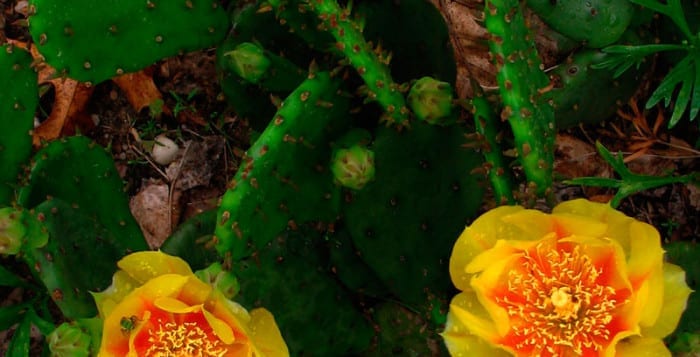By Ellen Barcel
Last week I wrote a column about planning a garden with the idea of making jams and jellies out of unusual plants: passionfruit, beautyberry and even Kousa dogwood. All are beautiful landscape plants but have the added bonus of edible fruit.
Well, there’s another fruit that can be used to make jams and jellies, as well as wine, and has the added benefit that it doesn’t need a lot of water since it’s a cactus. Opuntia, the prickly pear cactus, is native to much of North America and was most likely first used as food in Mexico, where it was known by the Aztec name “nopal.”
In the spring, the clumps of the cacti are filled with beautiful yellow flowers, which are followed later in the growing season by the fruit. Yes, Opuntia are flowering plants and like all true cacti are originally native to the Americas although they have been introduced to many other parts of the world.
The cactus fruit (also called cactus fig, Indian fig or “tuna” in Spanish) must be peeled carefully to remove the spines before eating. In Mexico and the American Southwest, the fruit is used in salads, soups, vegetable dishes and yes, jellies. I’ve even come across a recipe for cactus fruit gum drops that uses cactus fruit, applesauce, sugar and pectin. The pad, “nopal,” is also used in cooking.
Like so many cacti, a paddle (flat piece of the cactus) broken off from the main plant can be stuck in the ground and rooted to make more plants. Since pieces of cacti break off so easily from the main plant, this is an easy way of getting more plants.
The plants can also be grown from seed, since this is a flowering plant and the fruit does contain seeds. Like tomato plants, cut open a ripe cactus fruit, scoop out the gooey inside that has black dots and put it on some paper to dry. Separate the seeds out and plant them. On rare occasions, a plant will grow out of the fruit itself, like tomatoes can.
Remember, that cacti grow naturally in arid and semiarid climates. The worse thing that you can do to any cactus is to overwater it. In general, this is not a problem on Long Island, because despite our occasional deluges, we have sandy, i.e., well-drained, soil, so the prickly pear does well here. It even survives our winters. The paddles will dry up and sort of flatten out, but the plants will easily come back to life in spring.
If you decide to grow your prickly pear in containers, remember to make sure the containers have drainage holes and you use potting soil designed for cacti and succulents. I frequently see prickly pear cacti growing wild along the North Shore. A gardening friend of mine noted that Cedar Hill Cemetery in Port Jefferson is full of them and “the yellow flowers are beautiful.”
The fruit is ripe when, depending on variety, it is red or purple in color. Remember to be careful peeling it as it has not only large spines, but tiny ones as well, which can be very irritating.
Since there are so many varieties (I’ve read 181 species) of prickly pear, there are a number of different colors flowers. Opuntia ficus-indica (Indian fig prickly pear) is a large plant that has orange or yellow flowers, while O. basilaris (beavertail prickly pear) is a small plant but spreads. The variety that grows in the Northeast, i.e., Long Island, is called O. vulgaris, the eastern prickly pear. This is a comparatively small plant and so produces fairly small fruit.
If you find that your prickly pear isn’t bearing fruit, it’s too small, for example, you can find the fruit in many grocery stores in the produce section. These are usually from the western prickly pear and are much larger fruit.
Where you plant your cacti depends on several factors: sun (it prefers lots of sun), where the soil is dry and the ouch factor. Don’t put them near walk ways, children’s play areas or pools for obvious reasons.
Mine have survived winters outdoors but have remained small. I’m experimenting overwintering one grown in a pot indoors. When picking the fruit or transplanting the plants themselves, remember to wear gloves. Wrapping a cactus in newspaper is another way of handling it when transplanting.
Ellen Barcel is a freelance writer and master gardener. Send your gardening questions and/or comments to [email protected]. To reach Cornell Cooperative Extension and its Master Gardener program, call 631-727-7850.





